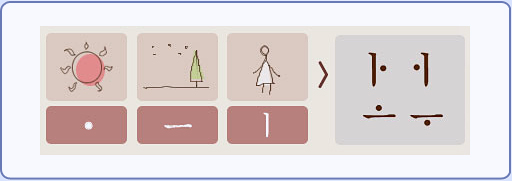The Korean alphabet, called Hangeul (한글) was created based on Confucian principles by King Sejong in 1443.
It consists of 21 vowels (모음 (mo-eum)) and 19 consonants (자음 (ja-eum)).
Each character makes use of the three main characteristics of the universe, according to the principles of Confucianism: Heaven, Earth & Man
It consists of 21 vowels (모음 (mo-eum)) and 19 consonants (자음 (ja-eum)).
Each character makes use of the three main characteristics of the universe, according to the principles of Confucianism: Heaven, Earth & Man
(source: http://english.visitkorea.or.kr/enu/CU/CU_EN_9_9_1_5.jsp )
Vowels (모음 mo-eum)
| ㅏ | ㅓ | ㅗ | ㅜ | ㅡ | ㅣ | ㅔ |
| ㅐ | ㅑ | ㅕ | ㅛ | ㅠ | ㅖ | ㅒ |
| ㅘ | ㅝ | ㅚ | ㅟ | ㅢ | ㅞ | ㅙ |
Consonants (자음 ja-eum)
| ㄱ | ㄴ | ㄷ | ㄹ | ㅁ | ㅂ | ㅅ |
| ㅇ | ㅈ | ㅎ | ㅋ | ㅌ | ㅍ | ㅊ |
| ㄲ | ㄸ | ㅃ | ㅆ | ㅉ |
자음(Consonants)
ㄱ = g
ㄴ = n
ㄷ = d
ㄹ = l/r
ㅁ = m
ㅂ = b
ㅅ = s
ㅇ = when used as a first consonant it has no sound, when used as a final consonant sounds like "ng"
ㅈ = j
ㅊ = ch
ㅋ = k
ㅌ = t
ㅍ = p
ㅎ = h
쌍자음(Double consonants)
ㄲ = gg
ㄸ = dd
ㅃ = bb
ㅆ = ss
ㅉ = jj
모음(Vowels)
ㅏ = a
ㅑ = ya
ㅓ = eo
ㅕ = yeo
ㅗ = o
ㅛ = yo
ㅜ = u
ㅠ = yu
ㅡ = eu
ㅣ = i
쌍모음(Double Vowels)
ㅐ = ae
ㅒ = yae
ㅔ = e
ㅖ = ye
ㅘ = wa
ㅙ = wae
ㅚ = oe
ㅝ = wo
ㅞ = we
ㅟ = wi
ㅢ = ui
When I first started learning Korean, reading hangeul was of course difficult at first. So I would always have with me those really helpful charts from joop.in
ㄱ = g
ㄴ = n
ㄷ = d
ㄹ = l/r
ㅁ = m
ㅂ = b
ㅅ = s
ㅇ = when used as a first consonant it has no sound, when used as a final consonant sounds like "ng"
ㅈ = j
ㅊ = ch
ㅋ = k
ㅌ = t
ㅍ = p
ㅎ = h
쌍자음(Double consonants)
ㄲ = gg
ㄸ = dd
ㅃ = bb
ㅆ = ss
ㅉ = jj
모음(Vowels)
ㅏ = a
ㅑ = ya
ㅓ = eo
ㅕ = yeo
ㅗ = o
ㅛ = yo
ㅜ = u
ㅠ = yu
ㅡ = eu
ㅣ = i
쌍모음(Double Vowels)
ㅐ = ae
ㅒ = yae
ㅔ = e
ㅖ = ye
ㅘ = wa
ㅙ = wae
ㅚ = oe
ㅝ = wo
ㅞ = we
ㅟ = wi
ㅢ = ui
When I first started learning Korean, reading hangeul was of course difficult at first. So I would always have with me those really helpful charts from joop.in
It also shows how to pronounce the alphabet.
With all the above we create syllables in order to create words. The consonants cannot be pronounced on their own therefore they are always combined with vowels.
It is important to imagine all the characters as if they are in boxes as shown in the following table:
| 한 | 글 |
| 안 | 녕 | 하 | 세 | 요 |












No comments:
Post a Comment